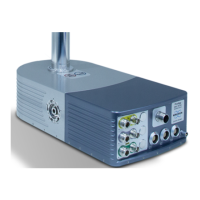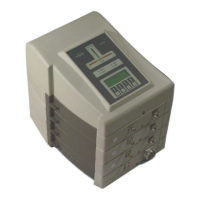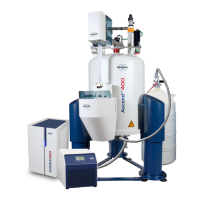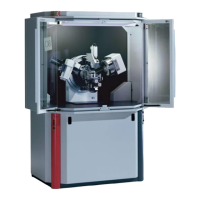48 (107) BRUKER CryoProbe User Manual
Standard procedures
Operating the Tuning Adapter
A CryoProbe is tuned and matched from below like a conventional probe with the
actuators of its specific Tuning Adapter (Figure 4.9.
). Long actuators are for tun-
ing, short ones for matching. Use the blue Tuning Tool to operate the actuators.
The common B
RUKER color code applies:
yellow:
1
H
white:
2
H
blue:
13
C
red:
15
N
CAUTION: Some of the tuning elements are factory-set and have no correspond-
ing actuator in the Tuning Adapter. Do not attempt to change them.
CAUTION: Do not force the actuators beyond their easily recognizable limits
(clockwise: stop, counter-clockwise: overrun). Do not challenge the limits of the
tuning and matching range if it can be avoided. Do not use tools other that the
Tuning Adapter to adjust the tuning or matching.
Use of additional RF filters
All necessary filters are already built-in the CryoProbe and the HPPR CRP. If ad-
ditional RF filters are considered, see "Additional RF filters" on page 58
.
In any case, additional RF filters must be included before tuning or matching is
done.
Shimming and Lock-in 4.13
0
For lock-in and shimming, the green C
OLD light should be on or at least flashing.
When C
OLD lights steadily, experiments can start.
Always obey the power limitations as given on the specific ‘L
IMITATIONS - WARN-
INGS’ sheet when sending RF power into the CryoProbe (see also "RF power lim-
itations" on page 58).
The usual X
WIN-NMR lock procedure can be used for lock-in. In contrast to the
1H and X channels, the lock channel of a CryoProbe may need as much (or even
more) RF power as a conventional probe. If in doubt about the lock power, per-
form an A
UTO LOCK POWER calibration with the BSMS keyboard and store the re-
sult in the CryoProbe’s edlock table.
If no lock wiggles can be found, the shim may be far off the optimum. Insert an
H
2
O/D
2
O sample and shim on the
1
H FID in the gs mode until the
2
H signal is
strong enough for lock-in.
Shimming can be done on the lock level as usual. There are no particular gradient
values to expect. Gradient shimming is recommended.
After lock-in and shimming, the CryoProbe is ready for NMR experiments. Consult
the "Recommended NMR parameters" on page 55
. Pay special attention to the
"Sample temperature control" on page 55
and to the "RF power limitations"
on page 58!

